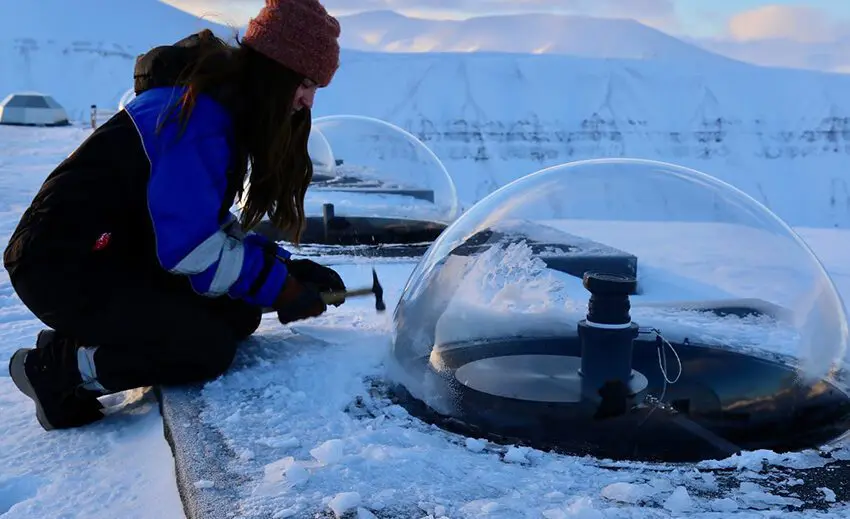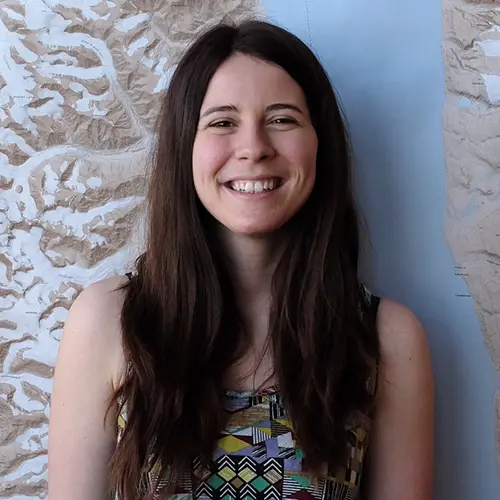Fast Flow Channels in the Polar Cap Ionosphere

Katie Herlingshaw cleaning domes on Kjell Henriksen Observatory
Top image: Being a PhD candidate in upper atmospheric physics is not only about computer work, it is also cleaning the camera domes on Kjell Henriksen Observatory free of ice and snow. Photo: Anja Strømme/UNIS.
PhD candidate Katie Herlingshaw has studied high velocity flow channels in the Earth’s upper atmosphere. In her thesis, a global network of radars is used together with optical measurements to investigate the properties of fast flow channels in Earth’s polar cap regions. Katie will defend her PhD thesis entitled ‘Characterising Mesoscale Fast Flow Channels in the Polar Cap Ionosphere’ on 22 January 2021 at 13:00.
18 January 2021
Press release from the University Centre in Svalbard (UNIS) and University of Bergen
The Earth’s magnetic field shields our planet and protects all life and technology within it from a constant stream of high energy particles from the Sun. Understanding the way in which the particles and magnetic field from the Sun interact with the Earth’s magnetic field and ionosphere is especially vital in the high-latitude, polar regions. Here, navigation and communication systems can be affected by structures in the ionosphere, so it is important to be able to forecast these changes. The large scale circulation of plasma in the ionosphere is well researched and modelled, but these models do not capture short lived and smaller structures.
Fast flow channels are thin regions where ionospheric plasma moves from one location to the next at high speeds of over 900 m/s. This thesis investigated the characteristics of the flow channels in addition to the typical driving conditions of the flow channels by the Sun’s magnetic field. An automatic algorithm for detecting flow channels within data from a global network of radars was developed to identify a vast number of flow channels in both the Northern and Southern hemispheres.
The findings show that fast flow channels are typically 200-300 km in width, with peak velocities of 1.1-1.3 km/s and durations of 2-3 minutes. The flow channels were observed most frequently when the Sun’s magnetic field was weak, fluctuating, and orientated in the dawn-dusk direction. The flow channels were most frequently observed soon after the magnetic fields of the Earth and Sun connected but they were also observed long after the connection occurred, deep within the polar cap. This research is a step towards a more comprehensive understanding of the role of mesoscale high velocity flow channels in the polar cap and their importance in the interconnected Sun-Earth system.
Disputation
Katie Herlingshaw will defend her PhD thesis entitled “Characterising Mesoscale Fast Flow Channels in the Polar Cap Ionosphere” on 22 January 2021 at 13:00. The disputation will be digitally.
More information on the disputation (University of Bergen)
The trial lecture was held in November 2020.
The committee consists of:
Professor Anita Aikio, Department of Physics, University of Oulu, Finland (opponent); Senior research scientist Mervyn Freeman, British Antarctic Survey, UK (opponent), and Associate Professor Kjartan Olafsson, Department of Physics and Technology, UiB (Chair of the committee).
Leader of the dissertation: Associate Professor Marius Opsanger Jonassen, Department of Arctic Geophysics, UNIS / Department of Geophysics, UiB
Katie Herlingshaw has been supervised by Associate Professor Lisa Baddeley, Department of Arctic Geophysics, UNIS (main supervisor); Professor Dag Lorentzen, Department of Arctic Geophysics, UNIS (co-supervisor) and Professor Kjellmar Oksavik, Department of Physics and Technology, UiB (co-supervisor).

About the candidate
Katie Herlingshaw is originally from Middlesbrough, England and completed her MPhys Physics with Astrophysics at The University of Leicester. After taking some courses at the University Centre in Svalbard in 2016, Katie returned in 2017 to take her PhD in the Arctic Geophysics department, in association with the University of Bergen and the Birkeland Centre for Space Science.
Contact information
Email: Katie.herlingshaw@unis.no